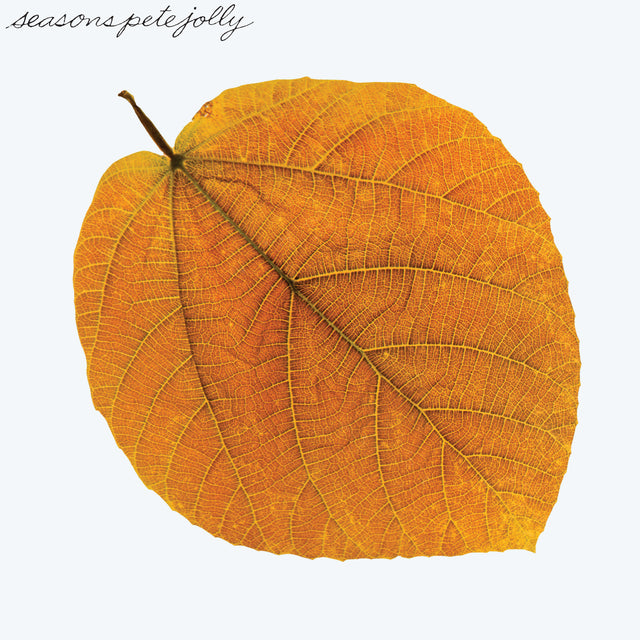Pete Jolly: Seasons by Dave Segal

As Berghofer—who played with Jolly for nearly 40 years until the keyboardist's death in 2004—relates in an interview with me, “At the time, I thought, 'What are we doing?' This was so dierent than anything else we ever did. Instead of straight-ahead tunes, it was a whole other world.” Sadly, Seasons has been out of print on vinyl since 1970 and was only reissued once on CD by the short-lived Dusty Groove imprint in 2007. That dearth has only increased heads' appreciation of this fascinating outlier over the decades. Fans have had to make do with YouTube rips or tapes from buddies unless they were wealthy and stealthy enough to score rare used copies online or even in thrift stores. (Recently, a Seattle-based friend of mine found two inexpensive copies of Seasons in thrifts, making him perhaps the luckiest person on Earth.) To give you an idea of how in-demand Seasons has been, British label owner Jonny Trunk put up an original pressing of the LP for sale for an undisclosed but large sum on Instagram in January 2023, and it sold in five minutes.
Of all the records that Jolly released, Seasons is the one that has accrued the most allure among collectors and aficionados. There's a good reason for that: there isn't anything that sounds as distinctive and mysterious as Seasons in Jolly's catalog, which largely consists of standards-heavy cool jazz and bop. Now, this work's top-tier stu, and Jolly's a musician’s musician; he played with distinguished jazzers such as Art Pepper, Gerry Mulligan, Chet Baker, Shorty Rogers, and Shelly Manne. But most vinyl hounds fervently fiend for the sample-worthy richness of Seasons.
Born in 1932, Jolly grew up in Phoenix, Arizona, which had a strong jazz scene pre-World War II. A prodigy who started playing accordion at age three, Jolly demonstrated his skills on that instrument on the Hobby Lobby TV show at age seven. He became an adept pianist as a youngster, as well, and at age 13 met and befriended the soon-to-be virtuoso jazz and rock guitarist Howard Roberts. When Roberts moved to Los Angeles in 1952, Jolly followed him and began to establish himself in that city's fecund jazz milieu, playing with Shorty Rogers' band and garnering many studio session dates. Jolly released the first of about a dozen studio albums in 1955 with Duo, Trio, Quartet for RCA Victor.

In the early 60s, Alpert discovered Jolly playing piano in a club on Sunset Boulevard called Sherry's. “Pete was playing there along with Chuck Berghofer on the bass,” Alpert recalls in a 2023 interview with me. “I was really struck by [Jolly's] amazing talent. His music really spoke to me.” Alpert signed Jolly to his A&M label, and Pete released three albums for it: Herb Alpert Presents Pete Jolly (1968), Give A Damn (1969), and Seasons. For the first album of the three, Alpert was hands-on, but Herb said, “Usually, I let the artists do their thing and give them a little feedback as I feel it. I never want to get in the way of an artist's creativity.” Unfortunately, Alpert's memory of the Seasons sessions is hazy, and he hasn't listened to the LP in decades.
Another aspect of Seasons that's unclear among two of its surviving principals: who picked the personnel. When asked if he helped to choose the musicians who played on Seasons, Alpert said, “No. I believed in Pete's taste. Any time you're dealing with an artist who's sensitive and great, they know what they want. I was always willing to give artists who recorded for A&M the latitude to pick and choose the artists that they feel most comfortable with.” However, Berghofer claims that it was Alpert who determined the lineup. “I made many albums with Pete, but [Seasons] was totally different from anything else we did, which was straight-ahead jazz. Pete did it because that's what Herb wanted to do.”
Whatever the case, Jolly's group brought serious pedigrees and chops: Berghofer did sessions with Nancy Sinatra and Frank Sinatra plus played the famous basslines on the Barney Miller theme and on Lee Hazlewood and Nancy's “These Boots Are Made For Walkin'”; percussionist Emil Richards was involved with Frank Zappa and Charles Mingus, among many prestigious others, and he did the finger snaps for The Addams Family theme and slapped bongos on Lalo Schifrin's theme for Mission: Impossible; drummer Paul Humphrey sat in with John Coltrane, Marvin Gaye, Jerry Garcia, the Supremes, and dozens more; guitarist John Pisano has served as a sideman for Chico Hamilton, Sérgio Mendes, and Ken Nordine; percussionist Milt Holland's credits include releases by The Beatles, the Rolling Stones, Captain Beefheart, and Joni Mitchell.
While Jolly certainly led the way in the improv session, and his larger arsenal of instruments added novel timbres, his fellow instrumentalists also deserve credit for Seasons' anomalous and sublime sounds. “Leaves” opens the record spectacularly with a gorgeous eorescence of Fender Rhodes piano, a pensive and sparse reverie to ease you into Jolly's special world. You can instantly glean why the track was sampled by artists such as De La Soul, Cypress Hill, and Redman. That's followed by the album's only standard, “Younger Than Springtime,” written by Rodgers and Hammerstein for the 1949 musical South Pacific. The ensemble renders it with suave cool, but as pleasant as it is, this piece feels like a concession to dinner-jazz aficionados. Much more exciting is “Bees,” whose manic tempo and chase-scene mood make it a jazzy infiltration into Kingsley/Perrey-style synth madness. The Berghofer-Humphrey rhythm section is on fire throughout, but Pisano’s psychedelic, fuzz-toned guitar deserves to have been mixed higher.
The 71-second “Rainbows” is a fiery organ fugue that could pass for the intro to a 90s Stereolab track. Seemingly a throwaway tune, “Rainbows” shows how ahead of and outside of their time Jolly and company were. Another highlight, “Plummer Park” glides into the subliminal funk vein of Sun Ra's “Twin Stars Of Thence.” Perhaps Humphrey—whose solo albums abound with funkiness—had a major role in steering the piece into head-nodding territory. Jolly gets o some amazing keyboard tones that are also ripe for enterprising hip-hop producers' MPCs. Similar groove magic occurs on “Springs,” on which Berghofer's sly funk bassline contributes to making it blaxploitation-flick soundtrack material of exquisite subtlety. Nightmares On Wax and Ugly Duckling had the good sense to sample “Springs.”
Written by Paul Williams collaborator Roger Nichols, “Seasons” is a gently cheerful, Wurlitzer-dominated tune that flirts with tweeness, but it still puts a spring in your step. You can hear it looped by former Cannibal Ox MC Vast Aire on “Look Mom No Hands.” The strangely undulating structure and tempo shifts in “Sandstorm” point to an almost Return To Forever-like complexity, albeit executed with much less bombast than Chick Corea's band. Another intricate, unusual meter guides “Autumn Festival” with a uniquely beautiful, melancholy mood conjured by Jolly on musette. What is this music? It's hard to pinpoint, but it is incredibly special.
Riding Humphrey's low-slung, quasi-martial soul-jazz-funk groove and augmented by Pisano's fuzz-toned rock guitar, “Prairie Road” induces shivers. “Indian Summer” —with brass arranged by Bill Holman—is another low-key groover with bongo/conga accents and Jolly's pellucid
Hammond clusters... until the last half when the mood shifts into climactic, James Bond-theme mode. It's the most demonstrative moment on this understated magnum opus. Finally, our humble bandleader ushers us to the exits with “Pete Jolly,” fueled by musette musings that cast a sentimental, morose spell despite Berghofer's stealthily funky bass line. Logic would dictate Seasons to end with “Indian Summer,” but Jolly had a perverse streak.
One of the amazing things about Seasons is how it sounds meticulously composed rather than spontaneously created in one brief encounter. Did the musicians take breaks, or was it all continuous playing? “I'm sure we took breaks,” Berghofer says, “but the only thing I can remember about the session is that we'd never done anything like that before—or since. It was just made up as you go along. He'd start playing, and we'd just follow him.
“He's the greatest jazz piano player in the world. He was so easy to play with. His time was so great. I'm sure [Jolly and Alpert] put a lot of the other stu on later. I don't remember all of us playing together. I remember a trio playing the first time through, and then they added stu to it.”
Seasons was Jolly's last album with A&M. Alpert says the relationship ended on good terms. “The albums didn't do as well as I hoped they would,” he says. “I guess Pete wanted to move on. He had some other situations, I think. We parted as friends. I love the guy. Pete was an extreme introvert. His music spoke for him as an artist. He was one of my favorite jazz musicians, and I don't think he got his fair due."
It's a testament to Alpert's aesthetics that he signed Jolly to A&M. Even though the records didn't sell that well, his music has real enduring value. “I think that's accurate,” Alpert says. “I thought that first album [Herb Alpert Presents Pete Jolly] was going to launch him a bit. It was certainly a little more commercial, but it had some really nice cuts on it; Earl Palmer was playing drums, and Chuck Berghofer was playing bass. I was a little disappointed that that album didn't take hold and give him more visibility. He does have a cult following, though. He was a special man—one of the great jazz musicians.”
Berghofer, his voice tremulous, says, “It's hard for me to talk about [Jolly] because I always tear up. There was nobody else like him.” What is it about Jolly's playing that aected Berghofer so deeply? “It's funny. We never played the blues together; we always played these tunes. Nothing was ever written out. I'd just gradually figure it out. His time was so perfect and he swung so hard. I never played with a piano player who could swing like Pete did. Toward the end of his life, he started falling apart just a hair but not much. Even when he was really ill, he could still play well.
During the main part of his life, there was nobody like him, and I've played with many pianists. “I learned so much from Pete. I miss him so much. He was a guide to me. He made me much better than I ever would have been had I not met him. He could've been much more popular if he had [promoted] himself at all. He never tried to be some big deal. He played and went home. And when we weren't working or had time o, he never touched the piano. Yet he could sit down and play after being o for three weeks.”
In all of Berghofer's many music activities, how does his musical relationship with Jolly rank? “Pete is still number one—always will be. After he passed away, I couldn't even put on a record of his for some time. I'd just start crying. I've got tears in my eyes right now from talking about him even though he's been gone for some time now. I think about him all the time.”
With Seasons back in circulation, maybe Pete Jolly will finally gain the broader audience that his phenomenal skills merit. If nothing else, it serves as a valuable lesson to artists: venturing outside of your comfort zone can bring the most interesting, enduring results.
— Dave Segal
Seattle, Washington
2023
Featured in this article:











